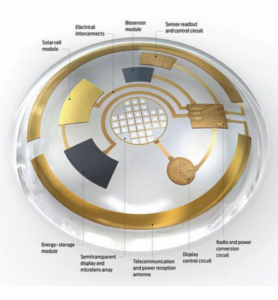We saw how much of the buzz at CES was around virtual and augmented Reality (VR and AR), and the smartphones or near to eye micro-displays that power them. Out on the display horizon looms something even closer to the eye, smart contact lens technology that resides literally on-eye with the potential for display development to change everything yet again.

We’re talking about “functional contacts” also known as smart eyewear displays, that are worn on-eye, and whose development is based on the foundation of bio sensor work already being done. A recent report on both Near to Eye (NTE) and on-eye technology was published by IDTechEX. Principal analyst in the space, Dr. Harry Zervos, authored a study on eye-worn electronics for the research company.
![]() As far back as 2011, researchers have demonstrated a single pixel on a contact lens
As far back as 2011, researchers have demonstrated a single pixel on a contact lens
Zervos says we are currently in a “second wave” of wearable component development with sensors designed from scratch to be wearable and fit our on-eye and near to eye needs.
He emphasizes that most Gen 1 work in this space comes from medicine, where labs creating bio sensors for the eye have been around since the beginning of the decade.
For example, in 2010, contact lens technology was used to test for glaucoma and since then, Swiss company, Sensimed AG’s launched its Triggerfish technology. It uses a strain gauge that encircles the contact lens along with an on-board microprocessor measuring the diameter of the cornea. It’s a commercially available eye wear device that embeds a its micro sensor into a disposable silicon-based contact lens that more precisely, “…captures spontaneous circumferential changes at the corneoscleral area. It provides an automated recording of continuous ocular dimensional changes over a 24 hour period,” the company said, with data that is used to literally save the sight of the patient.
Others working in the bio sensor field include Google. In 2014, the group put funds from its Google X project into a lab effort at the University of Washington to develop eye-worn technology to monitor glucose levels in diabetics. The group is working with Swiss drug maker Novartis, with trials to begin this year, on technology licensed from Google to track blood glucose levels. The development also includes an auto-focusing “smart lenses” to help the eye get beyond hyperopia and myopia. We are still talking about a five-year product window, according to the Sept 15 announcement from the drug maker. In June 2015, Canada-based start-up firm Medella announced it will make a smart contact lens targeting diabetics, that connects directly with a smartphone to send data to caregivers.
In a recent webinar presentation from IDTechEx, the company showed a prototype lens with modules that are likely to be needed to create an eye-worn display. This was first shown at the University of Washington, and reported in IEEE Spectrum with a concept drawing provided by Emily Clarke. This module includes:
- a peripheral antenna to collect incoming RF energy and telecommunication (provided by a separate portable transmitter, perhaps even a smartphone)
- power conversion circuitry and electronic interconnects that feed DC power to the components
- display drive circuitry
- semi-transparent display (micro lens array) LED- or LCD-based
- solar cell and energy storage modules (capacitor perhaps)
- bio sensors
Much of the technology needed in the medical / bio space can also be leveraged for contact-worn displays, including wireless power and chip, antenna design, encapsulation, and sensor miniaturization, all key development areas needed to empower eye-worn electronics according to Zervos.
So, while the hot ticket at this year’s CES seemed to be VR, look to a small silicon lens packed with electronics on a scale once thought the stuff of science fiction. On-eye displays, in one fell swoop, make all the talk of heavy head worn gear, battery packs, glasses and the geek factor, simply melt away.
But rest assured, the future generation of eye-worn displays will come with its own set of challenges and limitations, both technical and self imposed. But consider this; we may indeed be coming full circle, as the display of the future may eventually be no (external) display at all. And after billions of dollars in capital investment, research and human visioning, isn’t that an interesting prospect? – Steve Sechrist

